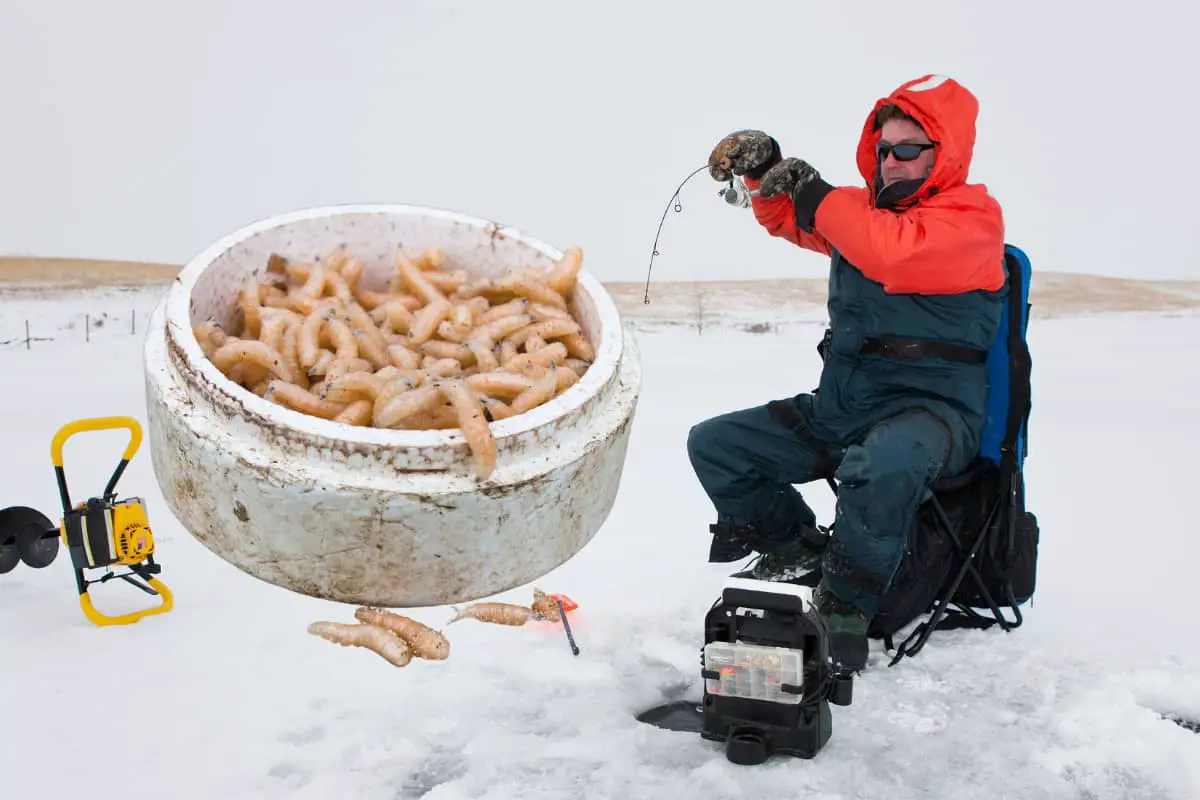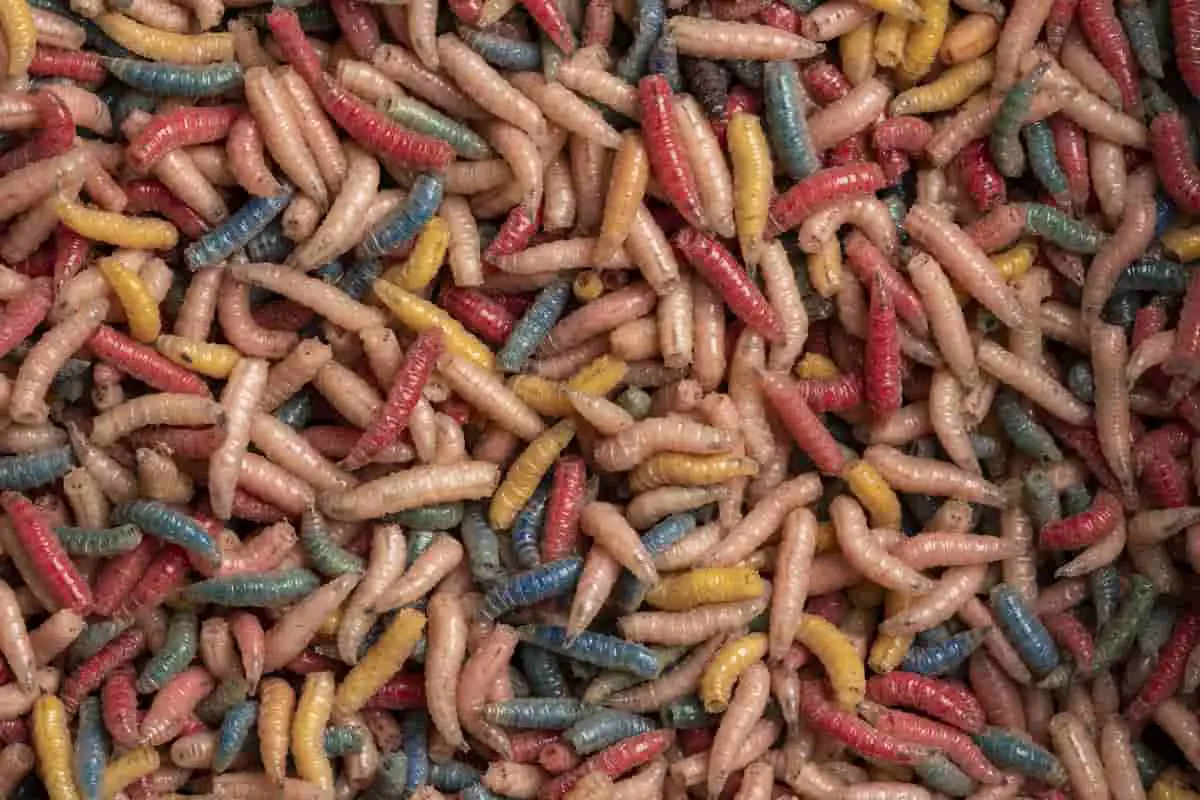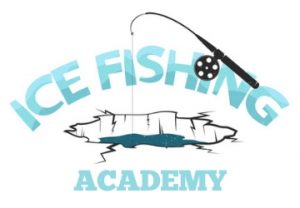A popular and plentiful bait for ice fishing is the spike! The trick is being able to keep them alive for longer periods and not finding them all brown and dead when you’re heading out the door!
Spikes remain alive for weeks when kept dry and refrigerated between 33 to 35 degrees. If they freeze, they will die. Transfer the spikes to a ziplock baggie with dry sawdust or cornmeal to keep them dry and remove any dead ones. Change the sawdust when it becomes moist. White spikes last longest.
Spikes are the all-around bait used by many for panfish, perch, trout, and bluegill! Spikes are responsible for many wins in major ice fishing tournaments.
They are inexpensive and easily obtained compared to other baits.
What is inconvenient is finding them hard, brown, and dead when you think they are still plump and juicy and ready to go fishing! It’s at least another 20-30 minutes to stop and buy new ones!
Here’s how you can keep your spikes alive and have them available for your next couple of trips unless the fish eat them all up!

How Long Will Spikes Last in the Fridge
In some households, if your wife finds them, they won’t last long at all! To help disguise them, use a small Tupperware container and place them in the back where they won’t be seen!
As a general rule, spikes will last between 3 to 6 months in your refrigerator with proper care. Keeping spikes dry and removing any dead ones you find will increase the amount of time they will live. Place the spikes in the coldest part of your refrigerator but don’t allow them to freeze.
What Temperature to Keep Spikes At
The optimum temperature to hold spikes at is between 33 to 35 degrees. Spikes will do best when kept at a temperature just above the freezing point of 32 degrees and die if the temperature drops to freezing or below.
Keeping spikes in a dry container inside your garage is a great alternative to using your refrigerator to keep them cold.
Temperatures in most attached garages don’t fall below freezing long enough to kill spikes if you have them in enough sawdust or cornmeal.
How Long Will Spikes Live
In nature, spikes will eat for a week and normally turn into a cocoon. Approximately two weeks after that, they will hatch into flies. When you keep spikes at cold temperatures, this stops the process – don’t allow them to freeze, or they will die!
I have friends who have ordered 1,000 spikes before ice fishing season. And within days, they turned brown and died. Take proper care of them, and they should last you most of the winter!
Keeping them cold in the refrigerator or garage at home will keep them in the preferred spike state for months.
When you’re fishing on the ice and in freezing temps, you’ll want to protect your spikes from the cold too!
To keep your spikes from freezing, use a small hand or toe warmer and place it next to your spikes inside your pocket.
When I’m using live bait, I use a bait puck to carry my bait instead of the fragile plastic cup that spikes are normally in when purchased.
If you’re fortunate, you’ll find a dealer who still uses durable pill bottles, so they don’t get crushed in your bib or coat pocket!
Insulated bait pucks help keep your spikes from freezing when you’re fishing. I also carry a handful of minnows in them when I’m on the go and moving around quite a bit.
What Are Ice Fishing Spikes
There always has been a little confusion on what an ice fishing spike is! They are often mistaken for maggots or other types of larvae.
Spikes used for ice fishing are the larvae of the bluebottle fly, while maggots are larvae from the common housefly. Both types of larvae are used as fishing bait. Since they are small, Spikes are more commonly used in the winter for panfish, perch, bluegill, crappie, and trout.
What Are Red Spikes for Fishing
Spikes are spikes! But they can be dyed in different colors by feeding them a diet that has added dyes. The spikes take on the colors they consume!

A common conception among ice fishermen concerns the durability and longevity of colored spikes. White spikes are considered to last the longest, while the red spikes are generally known as the second toughest.
In most fishing circles, the green spike tends to be the first of the colors to die off. I’m not aware of any scientific backing to this hypothesis, but we all know fishermen aren’t superstitious, right!
Are Spikes and Maggots the Same Thing
Spikes are small white larvae of the bluebottle fly about a half-inch long with two small black eyes. In comparison, maggots are slightly larger and the larvae of the common housefly. Both are used primarily as bait.
Spikes are used more during the ice fishing season as bait than they are during the summer. Although spikes can be deadly bait on small hooks for trout in mountain streams!
What Do Spike Worms Eat
Spikes and maggots generally feed upon live or rotten flesh. Flies are attracted to these smells and odors and deposit their eggs on them. The larvae, once hatched, will feed on the material they are deposited upon. For ice fishing purposes, spikes and maggots do not need to be fed.
Best Way to Carry Spikes While Ice Fishing
If you’re like me, you don’t like to sit around in one spot too long! I’m always on the move looking for actively feeding fish.
Having my bait in a flimsy plastic cup doesn’t do it for me. And I hate digging out old dried, dead bait from my ice suit pockets at the end of the season.
- Insulated Bait Puck – I keep a number of bait pucks in different sizes when I’m fishing. They are inexpensive, come in handy for other uses, and when fishing in a group it’s easy to divy up bait between us for the day. The small hockey puck size is perfect for spikes and maggots. They have a screw on lid, are insulated, and extrememely durable.
A cool tip for bait puck users on ATVs or sleds is to place a small patch of velcro on the bottom of the puck and stick it to a handy place on your machine!
This way, your bait is always within reach, and the screw lid keeps bait inside while the velcro keeps it on your machine at speed.
Have fun and stay safe out there!
